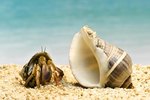Things You'll Need
Saltwater aquarium
Saltwater marsh habitat aquarium
Male and female blue crab
Blue crab fish food
Warnings
Keep the water at a constant temperature and in an area that doesn't receive bright light. Large changes in temperature and lighting could cause shock, illness, or death for the blue crabs.
Tips
Move the crabs from the saltwater environment to the saltwater marsh gently. Rough handling might cause the crabs undue stress, which would inhibit their mating rituals.
It may take many attempts before breeding is successful.
Soft-shell blue crab is a popular delicacy in Louisiana. Because the blue crab only has a soft shell for short molting periods, fisherman have difficulty catching the crab while its in the soft-shell state. Raising blue crabs in an aquarium is a solution for small quantities of the crustacean, but because the blue crab lives in both saltwater and saltwater marshes, replicating the crab's habitat is challenging. To raise blue crabs you will need to understand their mating rituals and preferences. The benefit of blue-crab farming is that one female can produce up to 2 million eggs. These eggs have a low survival rate in the wild, but in a controlled environment it's possible to reap a higher yield.
Keep the blue crabs in the saltwater aquarium during the crabs' natural hibernation period in the darker winter months.
Place the full-grown male and female blue crabs in the saltwater marsh aquarium. Blue crabs breed in the dense and nutrient-rich mud found in brackish marshes.
Allow the male to pick the female crab up and carry her around. Blue crabs only mate when the female is full-grown and in her final stage of molting. The male will carry her for a few days before and after their mating session.
Place the female and male back into the saltwater aquarium after they have finished mating and are no longer attached.
Keep the salt water aerated and filled with nutrients so that the eggs will have nourishment when they become free floating larvae.
References
Photo Credits
-
crab image by Andrew Buckin from Fotolia.com
Writer Bio
Sarah Snow began working as a freelance writer in 2010. She has worked in finance management, supply-chain management and currently works in public relations and creative development in the film industry. Snow holds a Bachelor of Arts in English and creative writing from Stanford University.




